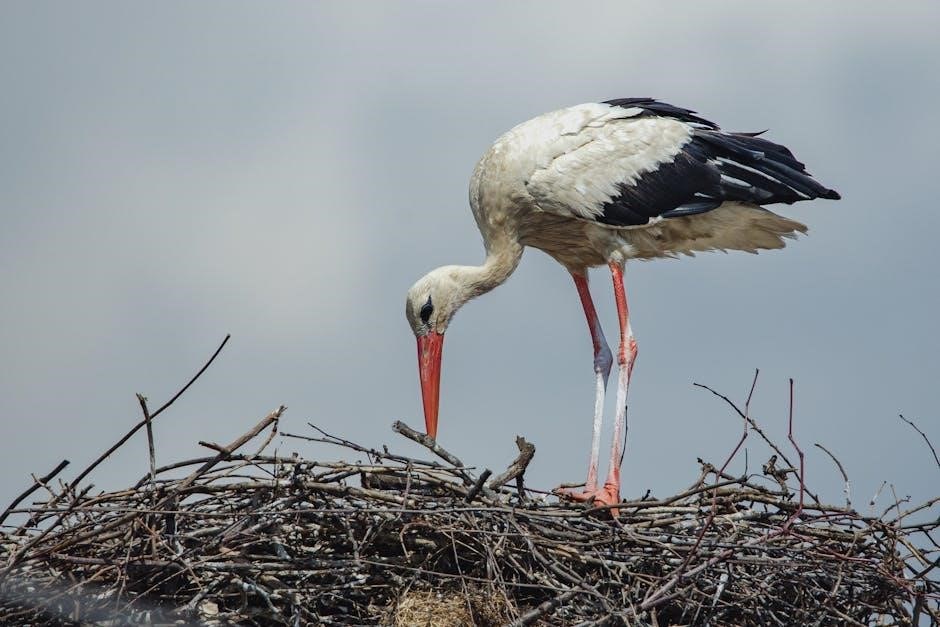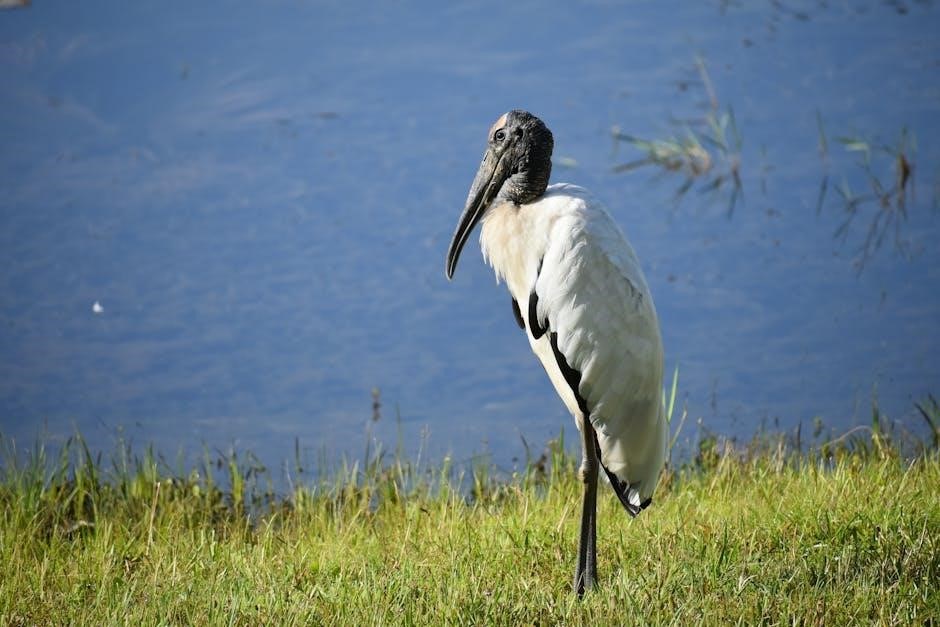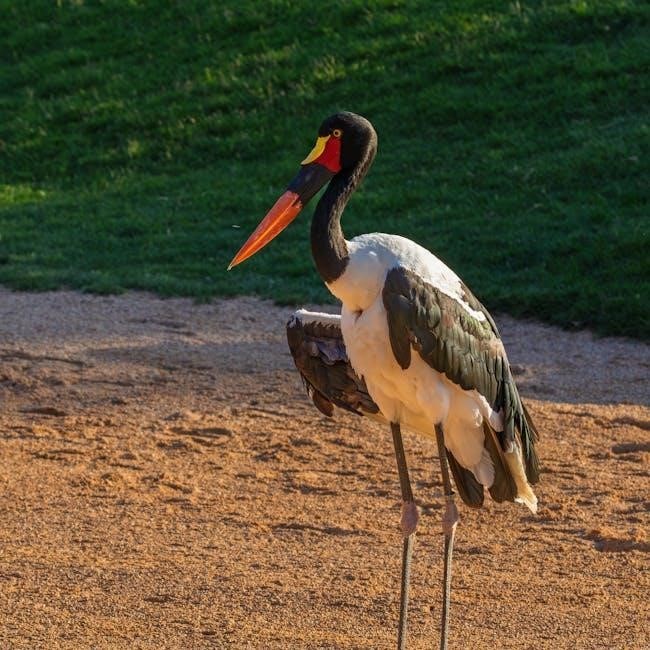1.1 Overview of the Book
Its Not the Stork! is a engaging guide by Robie H. Harris and Michael Emberley, designed for young children to explore their bodies and understand where babies come from. Using simple language and colorful illustrations, it answers children’s natural questions about gender, families, and growth, making it an essential resource for early education and open conversations.
Its Not the Stork! is a groundbreaking children’s book written by Robie H. Harris and illustrated by Michael Emberley. Designed for young children aged 4 and up, it addresses their natural curiosity about their bodies, where babies come from, and the differences between girls and boys. The book uses simple, clear language and engaging artwork to provide age-appropriate answers to questions that often arise during early childhood. It is part of a series that includes It’s Perfectly Normal and It’s So Amazing!, catering to different age groups. This book is not only a valuable resource for children but also a trusted guide for parents, educators, and caregivers. By fostering open and honest conversations, it helps build a foundation of understanding and comfort about the human body and family relationships. Its accessible format and reassuring tone make it a beloved and essential tool for early childhood education.
1.2 Purpose and Objectives
The primary purpose of Its Not the Stork! is to provide young children with a clear, age-appropriate understanding of their bodies, families, and how babies are made. The book aims to address the natural curiosity of preschoolers, kindergarteners, and early elementary students about their bodies and origins. By using straightforward language and engaging illustrations, the authors seek to empower children with accurate and reassuring information. The objectives include fostering open conversations between children and their caregivers, promoting a healthy understanding of gender and relationships, and helping children feel comfortable with their own bodies. The book also serves as a resource for parents, educators, and healthcare providers to navigate these sensitive topics with ease. Its ultimate goal is to lay the groundwork for lifelong learning about the human body, family dynamics, and emotional well-being in a way that is both accessible and comforting for young minds.

1.3 Key Features and Benefits
Its Not the Stork! offers several key features that make it an invaluable resource for young children and their caregivers. The book is written in a lively, comfortable language that is easy for preschoolers to understand, while its sensitive and engaging artwork by Michael Emberley ensures that the content is both visually appealing and reassuring. One of its standout benefits is its ability to address difficult topics in a way that is both age-appropriate and scientifically accurate. The book also serves as a tool for fostering open and honest conversations between children and their parents, teachers, or healthcare providers. Additionally, it provides a foundation for understanding gender, family relationships, and the basics of human reproduction, helping children build a positive and confident self-image. Its clear structure and thoughtful approach make it a trusted companion for early childhood education and development.

Background Information
Its Not the Stork! is part of a trusted series by Robie H. Harris and Michael Emberley, following It’s Perfectly Normal and It’s So Amazing!. This book, designed for children aged 4 and up, provides a foundational understanding of bodies, families, and where babies come from, fostering open and age-appropriate conversations.

2.1 Publication Details and Editions
Its Not the Stork! was first published in 2006 by Candlewick Press, with Robie H. Harris as the author and Michael Emberley as the illustrator. The book is part of The Family Library series, which includes It’s Perfectly Normal for older children and It’s So Amazing! for middle readers. The ISBN for the hardcover edition is 978-0-7636-3331-8, and it is also available in paperback and digital formats, including a widely accessible PDF version. This book is specifically designed for children aged 4 and up, making it an ideal resource for early education and family discussions. The publication has been praised for its age-appropriate content and engaging illustrations, making it a trusted choice for parents, educators, and healthcare providers.
2.2 Author’s Background and Expertise
Robie H. Harris is a renowned author known for her expertise in creating children’s books that address sensitive topics with honesty and simplicity. With a background in education and psychology, Harris has developed a unique ability to connect with young readers, making complex subjects accessible and engaging. Her work focuses on empowering children with accurate information about their bodies, families, and emotions. Harris has collaborated with illustrator Michael Emberley on several books, including It’s Perfectly Normal and It’s So Amazing!, which have become trusted resources for children and parents alike; Her approach is informed by consultations with healthcare professionals, educators, and parents, ensuring that her books are both reassuring and scientifically accurate. Harris’s commitment to fostering open conversations has made her a respected figure in children’s literature, particularly in the field of sex education and family discussions.
2.3 Illustrator’s Contribution
Michael Emberley’s illustrations in It’s Not the Stork! play a pivotal role in making the book accessible and engaging for young readers. His artwork is sensitive, yet playful, creating a visual language that complements Robie H. Harris’s straightforward text. Emberley’s ability to depict complex topics with simplicity and humor helps children feel comfortable exploring sensitive subjects. His illustrations are meticulously designed to avoid inappropriate details while maintaining scientific accuracy, ensuring the content is age-appropriate. By balancing visual appeal with educational value, Emberley’s work enhances the book’s ability to foster open and honest conversations about bodies, families, and growth. His collaboration with Harris has been instrumental in creating a trusted resource for children, parents, and educators, making It’s Not the Stork! a visually engaging and reassuring guide for young minds.
2.4 Cultural and Educational Impact
It’s Not the Stork! has made a significant cultural and educational impact by addressing children’s natural curiosity about their bodies and origins. The book has been praised for its ability to bridge gaps in early sex education, providing a foundation for open conversations between children and adults. Culturally, it challenges traditional myths and misconceptions, such as the idea that storks deliver babies, by offering clear, age-appropriate explanations. Educationally, it serves as a valuable tool for parents, teachers, and caregivers, helping them navigate discussions about gender, families, and growth. The book’s inclusive approach has resonated globally, making it a trusted resource across diverse cultures and educational settings. Its impact lies in empowering young children with knowledge, fostering a healthy understanding of their bodies, and encouraging a positive, informed view of themselves and their place in the world.

Target Audience
It’s Not the Stork! is primarily designed for young children aged 4 and up, including preschoolers, kindergarteners, and early elementary students. It also serves as a valuable resource for parents, educators, and caregivers seeking to address children’s natural curiosity about their bodies and families in a gentle, age-appropriate manner.
3.1 Age Range and Appropriateness
It’s Not the Stork! is specifically tailored for children aged 4 and up, making it an ideal resource for preschoolers, kindergarteners, and early elementary students. The book’s content is carefully designed to align with the developmental stages of young children, ensuring that the information is both accessible and appropriate. The simple, engaging language and vibrant illustrations by Michael Emberley help maintain the interest of younger readers while addressing their curiosity about their bodies and where babies come from. The topics are presented in a way that is easy for children to understand, without overwhelming them with complex details. This makes the book a perfect tool for parents and educators seeking to introduce fundamental concepts about anatomy, family, and relationships in a gentle and reassuring manner. The age-appropriate approach ensures that children receive accurate and straightforward answers to their questions, fostering a healthy understanding of their bodies and the world around them.
3.2 Educational Value for Children
It’s Not the Stork! holds significant educational value for children, providing clear and age-appropriate information about their bodies, families, and relationships. The book addresses young children’s natural curiosity about where babies come from and what makes them unique, offering answers that are both reassuring and scientifically accurate. By using simple, engaging language and vibrant illustrations, it fosters a positive and healthy understanding of anatomy, gender, and growth. The book also encourages open conversations between children and adults, helping to build trust and confidence. Its educational approach ensures that children receive accurate and straightforward information, free from misconceptions, while promoting a sense of self-awareness and respect for diversity. This makes it a valuable resource for parents, educators, and caregivers seeking to support young learners in their journey of discovery and understanding the world around them.

3.3 Role of Parents and Educators
Parents and educators play a vital role in introducing It’s Not the Stork! to children, as it serves as a valuable tool for fostering open and honest conversations about sensitive topics. The book’s clear, age-appropriate language and engaging illustrations make it easier for adults to address children’s questions about their bodies, families, and relationships. By using this resource, parents and educators can provide accurate and reassuring information, helping children build a healthy understanding of themselves and the world. The book also encourages trust and confidence between children and adults, creating a safe environment for discussions about growth and development. Additionally, it supports educators in integrating these topics into their curriculum, ensuring that young learners receive consistent and scientifically accurate information. Ultimately, It’s Not the Stork! empowers parents and educators to guide children through their natural curiosity, making it a trusted and essential resource for early childhood education.
The Team Behind the Book
Robie H. Harris and Michael Emberley collaborated on It’s Not the Stork!. Harris, a renowned author, and Emberley, a celebrated illustrator, bring their expertise to create a trusted and engaging resource for young children. Their teamwork ensures the book is both informative and accessible.
4.1 Robie H. Harris: The Author
Robie H. Harris is a celebrated author known for her expertise in creating children’s books that address sensitive topics with clarity and sensitivity. Her work focuses on empowering young minds to understand their bodies, families, and relationships. Harris collaborated with illustrator Michael Emberley on It’s Not the Stork!, ensuring the content is age-appropriate and scientifically accurate. She consulted with professionals, including educators, healthcare providers, and psychologists, to craft a reassuring and informative narrative. Her ability to tackle complex subjects in a gentle, engaging manner has made her a trusted name in children’s literature. Harris’s books, including It’s Perfectly Normal and It’s So Amazing!, are widely praised for fostering open conversations between children and adults. Her dedication to providing accurate and accessible information has made It’s Not the Stork! a cornerstone of early childhood education and a valuable resource for parents and educators alike.

4.2 Michael Emberley: The Illustrator
Michael Emberley is a renowned illustrator whose work brings warmth and clarity to complex topics for young children. His illustrations in It’s Not the Stork! are engaging, sensitive, and reassuring, helping children feel comfortable exploring their bodies and relationships. Emberley’s art complements Robie H. Harris’s text perfectly, using simple yet expressive visuals to convey important concepts. His ability to balance humor with subtlety makes the book accessible and non-threatening, encouraging children to ask questions and seek understanding. Emberley’s collaboration with Harris ensures that the book is both informative and visually appealing, making it a trusted resource for parents, educators, and children alike. His illustrations have been praised for their sensitivity and effectiveness in addressing delicate subjects, making It’s Not the Stork! a standout in children’s literature. Emberley’s work continues to empower young minds, fostering a healthy understanding of their bodies and the world around them.
4.3 Editorial and Design Contributions
The editorial and design team played a crucial role in shaping It’s Not the Stork! into a clear and engaging resource for young children. Their meticulous attention to detail ensured the content was age-appropriate and scientifically accurate. The design elements, including layout and typography, were carefully chosen to make the book visually appealing and easy to navigate. The team’s efforts ensured that the sensitive topics were presented in a way that was both reassuring and accessible, fostering open conversations between children and adults. Their contributions helped create a book that is not only informative but also a comforting tool for exploring complex subjects. The seamless integration of text and illustrations, guided by the editorial team, enhances the book’s effectiveness in addressing children’s natural curiosity about their bodies and the world around them. Their work has been instrumental in making It’s Not the Stork! a trusted and beloved resource for many families and educators.

Key Topics and Content
It’s Not the Stork! explores essential topics such as understanding the human body, explaining birth and babies, and discussing family, relationships, and friendships. These subjects are presented in a clear, reassuring manner, helping children grasp fundamental concepts about themselves and their world. The book’s content is tailored to address young children’s natural curiosity, providing straightforward answers to questions about their bodies and how families grow. By covering these key areas, the book serves as a foundational resource for early learning and open discussions about growth, identity, and relationships. Its engaging approach ensures that children feel comfortable and informed as they navigate these important topics.
5.1 Understanding the Human Body
It’s Not the Stork! provides a clear and age-appropriate introduction to the human body, helping children understand the basics of anatomy and biology. The book uses simple, engaging language to explain the differences and similarities between girls’ and boys’ bodies, while also introducing concepts like body parts and their functions. Through Michael Emberley’s lively illustrations, the book makes complex topics accessible, ensuring children feel comfortable and curious about their own bodies. Robie H. Harris addresses questions about growth, development, and the natural changes that occur as children grow, fostering a positive and healthy understanding of their physical selves. The content is carefully crafted to be both informative and reassuring, encouraging children to ask questions and seek knowledge about their bodies in a safe and supportive way. This section serves as a foundational tool for early education, promoting body awareness and self-acceptance from a young age.
5.2 Explaining Birth and Babies
It’s Not the Stork! gently and accurately explains the concepts of birth and babies to young children. The book addresses their natural curiosity about where babies come from, using simple, reassuring language. It describes how babies grow inside a uterus and how they are born, while also explaining the differences between boys and girls in an age-appropriate way. The illustrations by Michael Emberley complement the text, helping children visualize the process without overwhelming them. The book also touches on diverse family structures and relationships, emphasizing that babies come into families in many ways. By providing clear and scientifically accurate information, It’s Not the Stork! helps children develop a healthy understanding of birth and babies. This section fosters open conversations and encourages children to ask questions, making it an invaluable resource for early learning and emotional growth. The approach is both sensitive and engaging, ensuring children feel comfortable exploring these important topics.
5.3 Family, Relationships, and Friends
It’s Not the Stork! also explores the importance of family, relationships, and friendships in a child’s life. The book explains that families come in many forms, such as single parents, same-sex parents, or extended families, emphasizing that love and care are what define a family. It also discusses how children make friends and navigate relationships, highlighting the value of kindness, respect, and communication. The text reassures young readers about their feelings and helps them understand how to interact with others in a positive way. Additionally, the book addresses the role of parents, caregivers, and educators in fostering healthy relationships and providing support. By promoting inclusivity and empathy, It’s Not the Stork! helps children build a strong foundation for understanding and appreciating the diverse world around them. This section is designed to encourage open conversations about family dynamics and social interactions.
Importance and Impact
It’s Not the Stork! is praised for its role in promoting age-appropriate education about bodies, families, and relationships. It encourages open conversations between children and adults, fostering understanding and self-esteem. The book’s gentle yet frank approach has made it a trusted resource for families and educators, empowering young minds with accurate and reassuring information about growing up.
6.1 Promoting Age-Appropriate Education
It’s Not the Stork! excels at providing age-appropriate education for young children, addressing their natural curiosity about bodies, babies, and families. Designed for children aged 4 and up, the book uses clear, simple language and engaging visuals to explain complex topics in a way that is both accessible and reassuring. By tackling questions about gender, growth, and relationships, it helps children develop a healthy understanding of themselves and the world around them. The book’s approach is scientifically accurate yet sensitive, ensuring that children receive reliable information tailored to their developmental stage. This makes it an invaluable resource for parents, educators, and caregivers seeking to foster open, honest conversations about growing up. Its thoughtful design ensures that young learners feel comfortable and supported as they explore these essential topics.
6.2 Encouraging Open Conversations
It’s Not the Stork! plays a vital role in fostering open and honest conversations between children and their caregivers. The book’s straightforward approach to sensitive topics creates a safe space for kids to ask questions and seek clarity about their bodies, families, and how babies are made. By using simple, age-appropriate language and engaging illustrations, it encourages children to express their curiosity without fear or embarrassment. Parents, educators, and caregivers often find it challenging to address these topics, but this book provides a reliable and reassuring tool to guide the discussion. Its emphasis on clear communication helps build trust and understanding, empowering children to feel comfortable discussing their questions and concerns. This openness not only strengthens relationships but also lays the foundation for healthy attitudes toward growth, development, and relationships in the years to come.

6.3 Building Self-Esteem and Confidence
It’s Not the Stork! significantly contributes to building self-esteem and confidence in young children by providing clear, accurate, and reassuring information about their bodies and development. The book’s approach helps children understand that their questions and feelings are normal, fostering a positive self-image. By addressing topics like gender differences and family structures in a matter-of-fact way, it promotes acceptance and inclusivity. The engaging illustrations and simple language make complex concepts accessible, allowing children to feel empowered by their knowledge. This understanding helps them navigate social interactions with confidence and reduces anxiety about their bodies. Parents and educators can use the book as a tool to reinforce positive self-perceptions, ensuring children grow up with a healthy and confident outlook on themselves and their place in the world.
Its Not the Stork! is a groundbreaking resource that empowers young children with age-appropriate knowledge about their bodies and families. Its gentle approach fosters open conversations, building confidence and self-esteem, while its legacy ensures future generations will benefit from its timeless wisdom.
7.1 Final Thoughts on the Book’s Value
Its Not the Stork! stands out as a vital resource for young children, offering clear and reassuring answers to their natural curiosity about bodies, babies, and families. Written by Robie H. Harris and illustrated by Michael Emberley, the book is praised for its gentle, age-appropriate approach, making it a trusted guide for parents, educators, and healthcare providers. Its engaging language and vibrant artwork create a comfortable space for children to learn about their bodies and the world around them. The book’s ability to foster open conversations and provide scientifically accurate information ensures it remains a cornerstone of early childhood education. By addressing sensitive topics with care and honesty, Its Not the Stork! empowers children with knowledge, helping them grow into confident and informed individuals. This book is not just a resource but a foundational tool for nurturing young minds.
7.2 Recommendations for Readers
Its Not the Stork! is highly recommended for parents, educators, and young children aged 4 to 8. This book serves as an excellent tool for initiating open and honest conversations about bodies, babies, and families. Readers are encouraged to use the book as a starting point for discussions, helping children feel comfortable asking questions and seeking answers. The clear, age-appropriate language and engaging illustrations by Michael Emberley make it accessible and enjoyable for young minds. Parents and educators can use this resource to foster understanding, promote self-esteem, and provide accurate information about growth and development. Reading the book together with children can enhance its impact, creating a safe and supportive environment for learning. Its Not the Stork! is not just a book but a valuable guide for navigating the natural curiosity of childhood.
7.3 Legacy and Future Impact

Its Not the Stork! has left a lasting legacy as a foundational text in children’s education, empowering young minds with accurate and age-appropriate information. By addressing topics like bodies, babies, and families in a gentle yet honest way, the book has become a trusted resource for generations. Its impact extends beyond individual readers, influencing how parents, educators, and caregivers approach conversations about growth and development. The book’s legacy lies in its ability to foster curiosity, understanding, and confidence in children, helping them navigate the world with clarity and self-assurance.
Looking ahead, Its Not the Stork! will continue to shape the way children learn about their bodies and families. Its availability in formats like PDF ensures accessibility for a wider audience, making it a timeless tool for education and open dialogue. As a cultural and educational landmark, this book will remain a vital resource for years to come, empowering future generations to embrace their questions and seek knowledge with confidence.